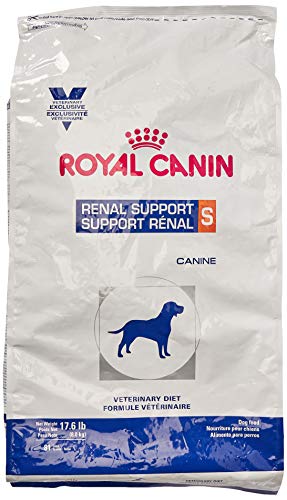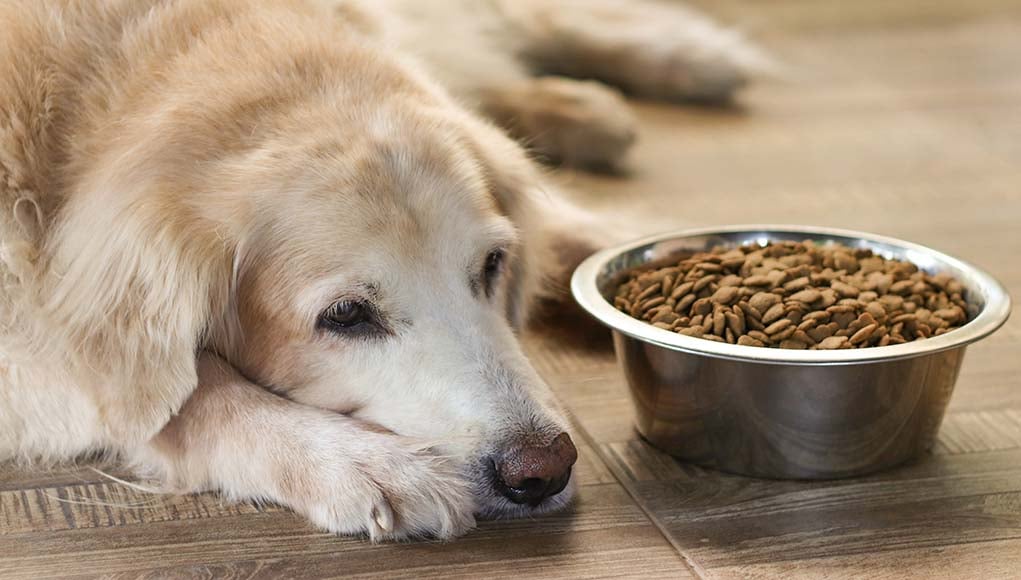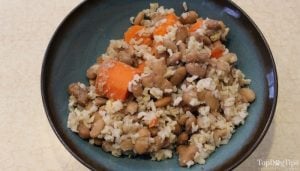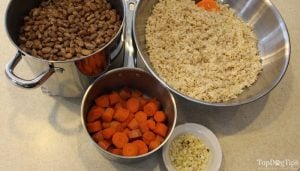Table of Contents
Once the vet informs you that you need to change to a low-protein diet for dogs, the questions start popping up: what is a low-protein food, where can you buy it, will your dog like it, how low in protein the diet should be, and more.
Here's everything you should know about a low-protein diet for dogs.
When is A Low-Protein Diet for Dogs Needed?
It is not up to you to decide whether your dog needs a low protein diet. If done improperly, decreasing protein intake can do a lot of harm to your dog.
Switch your dog to a low-protein diet only if your vet prescribes it.
A low-protein diet for dogs is often recommended when pets have a medical condition that affects the functions of their liver or kidneys or if they have a particular type of bladder stone.
Studies have shown that this type of diet improves the condition, makes dogs feel less lethargic, and even extends the lifespan of terminally ill dogs (1, 2).
The liver and kidneys contribute to metabolizing proteins in the dog's body.
When either of these organs is already under significant strain due to other dysfunction (e.g., liver disease, kidney disease), decreasing the amount of protein they need to process will prevent further complications, such as kidney failure (3).
This diet change may be permanent, especially if your pet has a chronic kidney or liver illness. It may also be temporary, such as in the case of bladder stones.
With the latter, you'll switch away from a low-protein diet and back to a normal diet when your dog gets rid of the stones (4, 5).
Research has shown that feeding a low protein dog food diet can lead to losing less protein through kidneys with dysfunction (6). Therefore, in these particular cases, less protein in the diet can paradoxically mean more protein supplied to your dog's body (7).
What Are the Side Effects of a Low-Protein Diet for Dogs?
Never decrease your dog's protein intake by yourself. While a low protein diet for dogs can be beneficial in certain cases, this dietary change needs to be taken extremely seriously and approached with caution.
Only a veterinarian can recommend your dog this type of diet, and they will give you the necessary advice on how to stick to it, a specific timeline, and even prescribe the appropriate food for your dog.
A low protein diet can have side effects such as losing weight and muscle mass, vitamin deficiency, and malnutrition – all of which lead to further health problems (8).
If you choose to feed your dog a low-protein diet on your own, you risk disregarding the other important nutrients that need to be compensated for.
This is why only a vet or canine nutritionist can design a low-protein diet for your individual dog.
Low protein diets are also known to weaken a dog's immune system and cause “mood swings,” exhaustion, muscle trembling, and melancholy.
These symptoms will be worse in the dogs that don’t actually need to be put on a low protein diet.
How Low in Protein Can a Low-Protein Diet for Dogs Be?
If you look, you will find several low-protein dog food brands available for purchase. However, not every low-protein dog food brand will fit your pet's requirements.
To understand the vet’s recommendation, you need to know how much protein your dog consumes daily.
Look at the dog food label. The protein content is expressed in percentages on a dry matter basis.
Recommended protein intake for an adult dog should be 18%, and for a puppy, this number is 28%.
Working and athletic dogs should consume about 25% of protein, while lactating dogs will need 28%.
Regular dog foods which you normally buy will contain around 20-25% of protein. Low-protein dog foods will vary in percentage, but you will usually halve the amount.
| Type/Growth Stage | Protein % | Fat % |
|---|---|---|
| Puppy | 28% | 17% |
| Adult dog | 18% | 9-15% |
| Performance dog | 25% | 20% |
| Racing sled dog | 35% | 50% |
| Lactating dog | 28% | 17% |
What Should You Feed Your Pet on a Low-Protein Diet for Dogs?
You have three options to agree with your veterinarian on in terms of the new diet:
- Buy a prescription dog food brand for a specific health condition (costly)
- Make low-protein homemade dog food meals (somewhat expensive)
- Buy regular dog food brands that are lower in protein (average priced)
The first option can be the easiest and most appropriate. Your veterinarian prescribes a particular dog food brand designed for the exact health issue that your dog has.
You'll need that prescription to buy the food, which you can sometimes purchase at the vet's clinic.
Prescription foods are the most expensive on the market, and they're also harder to find.
The second option is less expensive than prescription foods, but it's time-consuming. You need to design each meal with specific ingredients your dog requires while at the same time avoiding protein-rich foods.
You need to be extremely precise and follow instructions for a tee. Every homemade low-protein dog food recipe needs to be approved by your vet.
The third option is simply buying dog food from pet stores or online the way you normally do, except you'll need to pick from foods labeled “Low Protein.”
While this is the least expensive and time-consuming option among the three, it's not always possible to find the kind of low-protein dog food that fits your pet's current requirements.
Ask your vet which “regular” dog food brands they believe can be a good fit for your pooch.
Note: Make sure that you're veterinarian doesn't push for prescription dog foods only without explanation. There is no reason you cannot feed a dog a homemade diet as long as the vet has approved every recipe and you stay precise with ingredients. Always confirm whether you can buy a “regular” dog food brand instead of prescription foods, and if the veterinarian says it's not an option, ask them to explain why that is the case.
How to Make a Homemade Low-Protein Diet for Dogs
You can follow a low-protein diet for dogs with homemade recipes as long as your vet has approved them (here's an example recipe).
Before you decide to do that, you must understand the intricacies of such a dietary approach.
First, keep in mind is that all proteins are not the same. They are ranked based on the dog's body's ability to utilize a specific protein source (9).
This is the part that's vital to dogs on a low protein diet. A protein's “quality” is referred to as biological value.
Chicken Eggs have the highest biological value for protein (94/100 BV) among dog foods.
Thus, eggs present the point of reference for all other types of foods to be compared to, and it's the most common ingredient in a low protein diet for dogs (10).
Below are the rest of the foods ranked from the highest BV for protein:
Buckwheat: 90 BV
Cow's milk: 90 BV
Cheese: 84 BV
Quinoa: 83 BV
Rice: 83 BV
Fish: 76 BV
Beef: 74.3 BV
Eggs, fish, red meat, and poultry protein are good quality sources with decent BV (11).
For a homemade low protein diet for dogs, you need to account for this to accommodate your dog’s needs.
While soy and corn are also rich in usable protein, you should avoid them as they aren't necessarily the best food items for a canine.
When you're designing your pup's meals, you should always try to hit as many birds with as few stones, so seek out foods with a specific protein amount and BV and those that are also saturated with omega-3 fatty acids, vitamins, and minerals.
Additionally, how much protein your dog needs will also depend on their breed, daily life, habits, health history, and age, as well as the exact health issue they're currently dealing with.
This is why it's important for a low protein diet to be tailor-made by your vet and worked out specifically for your individual pet.
Best Low-Protein Dog Food Brands
Below are some of the best low-protein dog food brands you can buy instead of prescription dog food or homemade meals.
However, it would help if you were certain that the percentage of protein dry matter basis fits the needs of your individual dog – ask your veterinarian about each brand you're considering.
| Preview | Product | Rating | |
|---|---|---|---|

|
Diamond Pet Foods Naturals Lite - Lamb & Rice - 30... | 1,882 Reviews | Check Price |

|
ROYAL CANIN Canine Renal Support S Dry (17.6 lb) | 9 Reviews | Check Price |

|
Hill's Science Diet Dry Dog Food, Adult 7+ for... | 5,054 Reviews | Check Price |

|
Blue Buffalo Natural Veterinary Diet KS Kidney... | 337 Reviews | Check Price |
Sticking To The New Diet of Low-Protein
If your dog is used to eating a particular type of food, it is normal that they will find the change difficult at first.
Some owners find it easier to mix low protein dry dog food with a little bit of low protein wet dog food. It's more expensive but makes the switch easier.
Generally, when switching to a low protein diet for picky dogs, homemade foods are likely to have the best success ratio.
When you change your dog’s diet, your main task will be to stick to it. Don't forget about dog treats you give your pup between meals – they can be high in protein.
Make a plan for your dog’s meals and stick to that plan. There can be no more giving into your dog's puppy eyes.
If you are consistent in what you are offering them in the beginning, it will be easier for both of you in the future to control your pet's protein intake.
READ NEXT: Feeding Dogs With Renal Disease and Kidney Problems
Disclosure: We may earn affiliate commissions at no cost to you from the links on this page. This did not affect our assessment of products. Read more here and find full disclosure here.
Want to share this?
















